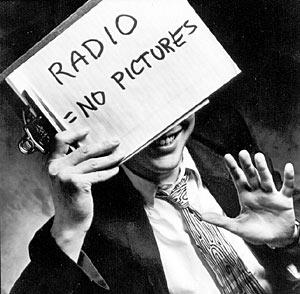 BY JONATHAN VALANIA For nearly half a century television has had to bear the “barren wasteland” rap. But even a cursory, static-smeared twist of the radio dial reveals a largely fallow garden. Corporate consolidation and play-it-safe programmers have conspired to increase the emphasis on the obvious, the ordinary and the lowest common denominator.
BY JONATHAN VALANIA For nearly half a century television has had to bear the “barren wasteland” rap. But even a cursory, static-smeared twist of the radio dial reveals a largely fallow garden. Corporate consolidation and play-it-safe programmers have conspired to increase the emphasis on the obvious, the ordinary and the lowest common denominator.
It doesn’t have to be like this.
“When correctly harnessed, radio can be as emotional, as funny and as satisfying as the best motion pictures and television shows,” says Ira Glass, host of public radio’s This American Life. “But sadly, few radio programmers even shoot for that.”
For the past eight years, Glass — and his coterie of whipsmart writers and producers — has been waging a regime-change insurgency to free radio from the tyranny of mediocrity.
And here’s the good news: He’s winning.
In 2001 Time magazine lionized him as “America’s Best Radio Host” in a glowing honorarium penned by David Mamet. This American Life has already snagged a Peabody Award, which is to broadcasting what the Pulitzer is to print. Each week 1.4 million people tune in to hear This American Life, heard locally on WHYY 91FM, Wednesday nights at 10 p.m. and Sundays at noon.
There have been book deals on the table and even TV show offers. [Ira discusses taking This American Life To The Boob Tube on today’s FRESH AIR] And more recently, a movie deal was inked with Steven Soderbergh’s production company, Section 8, to translate This American Life content to the silver screen.
In the process, Glass has become something of an egghead sex symbol. If the audience that turns out for his public appearances is any indication, a large portion of his listenership is comprised of willowy, well-read hotties sporting stylish eyewear. His current girlfriend is an editor at Playboy.
On paper, like so many things that come alive on the radio, This American Life’s magic is based on what seems like a flat and ordinary premise: telling stories.
Each week has a theme, which three or four writer/reporter/narrators explore in all its tangential glory, teasing out nuances, revelations and more often than not, laughs. Two of the show’s main attractions — the wry, lisping drollery of Sarah Vowell and the wicked, acid-bath wit of David Sedaris — have spun off into media stars in their own high orbit.
This American Life eschews the typically stilted, lacquered-haired syntax of broadcast locution. It’s all about the art of the carefully calibrated um. Where most radio editors see it as bad form to air the loose-lipped sputter of conversational English — the verbal tics, pauses, breaths, ums and uhs — Glass weaves them into broadcast, lending the storytelling a compelling casualness and a resonant, this-is-how-people-talk verite. Listeners are made to feel like they are eavesdropping on some juicy conspiracy or have gained entree to a really good inside joke.
Not everybody gets it. When Glass first pitched the show to NPR back in 1997 — after two years of grooming the show, scaring up production funds and self-syndicating to more than 100 stations from his perch at WBEZ in Chicago — the comfortable-shoed public radio bigwigs in Washington politely declined.
“They just didn’t get the show, like, they really didn’t understand what was good about it,” says Glass.
The 44-year-old Glass — who has managed to maintain the youthful aura of a postgrad slacker despite the 12- to 14-hour workdays — grew up in Baltimore, the son of a therapist mother and an accountant father (composer Philip Glass is a first cousin once removed). “Both of my sisters went to Penn,” he says. “Philadelphia always seemed like the glamorous downtown version of where we lived.”
He went to Brown and majored in semiotics, a highfalutin branch of literary criticism he’s dragged kicking and screaming out of the nebbishy world of academia and applied to everyday life.
“Semiotics is a fantastically pretentious body of theory that, um, gets really interesting when it talks about stories,” he says. “Old-school literary theory would look at a book or a movie and ask, ‘What did the author or filmmaker intend?’ Semiotics is utterly uninterested in what the author intended. What semiotics is interested in is the machinery of the story that keeps you reading. What is it about this story that keeps you reading where that story doesn’t? How can you create those effects? And for someone who is interested in telling stories, it’s like a nuts-and-bolts guide to making them compelling. I use it every day.”
Again, it’s all about the um.
